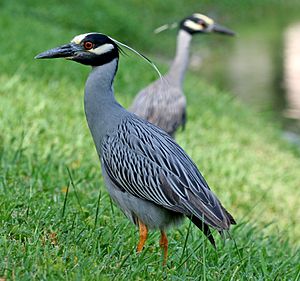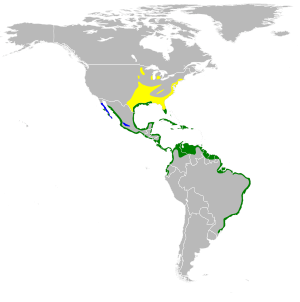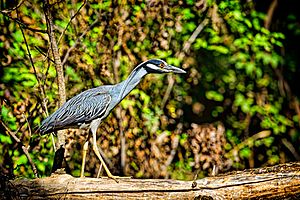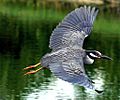Yellow-crowned night heron facts for kids
Quick facts for kids Yellow-crowned night heron |
|
|---|---|
 |
|
| At a pond in Tarpon Springs, Florida | |
| Conservation status | |
| Scientific classification | |
| Genus: |
Nyctanassa
|
| Species: |
violacea
|
 |
|
| Range of N. violacea Breeding range Year-round range Wintering range | |
| Synonyms | |
|
|
The yellow-crowned night heron (Nyctanassa violacea) is a type of night heron found in the Americas. It's one of two kinds of night herons living there, the other being the black-crowned night heron. People in France call it "bihoreau violacé," and in Spain, it's known as "pedrete corona clara."
Contents
Physical Features
Body Shape
The yellow-crowned night heron is a chunky wading bird. It stands about 55 to 70 centimeters (21 to 27 inches) tall. It weighs between 650 and 850 grams (1.4 to 1.8 pounds). Females are usually a bit smaller than males. This heron has a wingspan of 101 to 112 centimeters (40 to 44 inches). Its neck is thin when stretched out. It has a large head compared to its body, with a big, strong beak.
Colors and Markings
The body and back of this heron are a smooth grey-blue. Its wings have a black, scaled pattern. The long legs are yellow, but they turn coral, pink, or red during mating season. The most special part of the yellow-crowned night heron is its head. It is black and shiny, with white cheeks. A pale yellow crown goes from its beak, between its eyes, and to the back of its head. This yellow crown gives the bird its common name. These colors make its face look striped with black, white, black, and white bands. During mating season, long, thin, white feathers grow from the back of its crown. Its beak is black, thick, and set deep under its eyes. Its eyes are dark orange or red.
How They Fly
Like all herons, the yellow-crowned night heron flies with long, slow, strong wing beats. You might see it gliding over water with its legs easy to spot. Its legs are stretched straight out behind its tail. This is different from the black-crowned night heron, whose legs are hard to see when it flies.
Young Herons
It takes about three years for young yellow-crowned night herons to look like adults. Before that, young birds look different. They have brownish bodies and greyish heads. Their colors are dull, and their feathers have spots and streaks.
Adult yellow-crowned and black-crowned night herons are easy to tell apart. However, young yellow-crowned herons can look very similar to young black-crowned herons. Young yellow-crowned herons tend to stand straighter. They also have stronger beaks and longer legs. Their spots and streaks are finer than those of the black-crowned young.
Classification

The yellow-crowned night heron belongs to the heron family, called Ardeidae. This family also includes egrets and bitterns. They are also related to pelicans and ibises. Night herons are thought to have separated from day herons. Day herons include birds like the great blue heron and the green heron.
Scientists recognize five different types, or subspecies, of this heron. We don't know much about how these types mix together. We also don't know much about how their living areas change. Their body size gets smaller from north to south. The shape of their beaks also changes depending on where they live. This is because the size of the crustaceans they eat is different in various places.
A related heron, the Bermuda night heron, used to live only in Bermuda. But it became extinct after humans settled there.
Where They Live
The yellow-crowned night heron likes to live in shallow water. This includes marshes, wooded swamps, and lake shores for birds living inland. For herons near the coast, they live in thickets, mangroves, and rocky coasts. They can also be found in areas that don't always have water but get flooded often. Their home is closely linked to where the crustaceans they eat live. They can live in fresh water, brackish water (a mix of fresh and salt), and saltwater.
Another important thing for their home is nesting spots. Yellow-crowned night herons need bushes or trees to build their nests. If there are no plants, they will use rock ledges, like on cliffs.
Unlike the black-crowned night heron, the yellow-crowned heron doesn't mind living near people. You can find them in wooded neighborhoods. They sometimes build nests on rooftops and driveways. Living so close to humans can sometimes cause problems.
Where They Are Found and Travel
The yellow-crowned night heron lives only in the Americas. Where they are found depends a lot on where they can find food, mostly crustaceans.
Winter and Year-Round Homes
They spend winter where the weather allows crabs to be active all year. This includes tropical and subtropical areas. You can find them in south Florida, the Gulf Coast (from Louisiana to Alabama), and the eastern Texas coast. They also live in Mexico, Central America, Galápagos - Ecuador, the Caribbean, and northern South America. In coastal areas, they live as far south as Peru and Brazil. In these places, they usually stay all year.
Breeding Areas
From 1925 to 1960, the yellow-crowned night heron spread further north. The reasons for this are not fully clear. Today, besides their winter and year-round homes, they can be found in the southeastern United States during breeding season. Some groups have even been found breeding much farther inland, up to the northern border of the United States.
Migration
Different types and groups of these herons travel in different ways. Herons that live on islands or in warmer places usually stay put. Tropical herons do migrate, but how far they travel is not fully known because there isn't enough information. The way yellow-crowned night herons migrate has changed as they spread north. One type (Nyctanassa violacea violacea) travels to the northern parts of its range. They move north and west after breeding. Birds seen outside their normal areas are usually young birds or ones that have strayed.
Migration happens in mid-March in warmer places. In cooler places, it happens from mid-March to April.
Behavior
Sounds They Make
The most common sound the yellow-crowned night heron makes is a loud, sharp, and quick squawk. The bird makes this sound shortly after taking off. It also uses it as an alarm call or when it feels aggressive. Young herons beg for food with a soft chu-chu-chu call. This call gets louder as the chicks grow and need more food. Different sounds are very important during courtship and when pairs form. Males and females use a yup-yup call when they greet each other. They use a huh! call when they form a pair among other nesting birds. The male finishes his courtship display with a whoop. This sound may or may not lead to the pair actually forming.
What They Eat
The yellow-crowned night heron mainly eats crustaceans, like crabs and crayfish. They also eat insects, some fish, or worms. Sometimes, they might eat lizards, small rodents, and small birds. Where the heron lives affects what prey it can find. The size and shape of its beak help it hunt for specific sizes of prey.
This heron can look for food any time of day or night. However, it prefers to feed its young at night. It becomes very aggressive if another heron gets too close while it's hunting. But it will allow other herons to be about ten meters away. It finds prey by looking for it. It either stalks its prey or stands still and waits for it to come close. When hunting crayfish, the heron stands at the entrance of the burrow. It always faces the sun so its shadow doesn't fall over the entrance. This keeps the crayfish from being alerted. It can also walk slowly towards prey with its body bent and head pulled back. Then it stops and waits before walking slowly again. This helps it sneak up on crabs without them knowing. Sometimes, you might see it running in shallow water after prey. But it will not follow prey into deep water.
Once close enough, it lunges with its beak. Small prey are swallowed whole. For larger prey, like a big crab, it will try to break it apart. It eats the body first and the legs last. It might also stab the crab straight through the body. It will carry crabs, molluscs, or fish away from the water. This stops them from escaping.
Any parts it can't digest, like crab shells, are spit out in a pellet. It's common to find shells and pellets scattered around where they hunt and nest.
Reproduction and Life Cycle
Courtship and Nest Building
The yellow-crowned night heron's breeding season depends on when crabs appear in spring. The crab cycle itself depends on temperatures. So, the breeding season for this heron changes depending on where it lives. It usually happens between March and May. In some warm, tropical places, they can breed all year.
It's not fully clear how or for how long yellow-crowned night herons stay with a mate. Some herons arrive at breeding areas already in pairs. This means they either found a mate during their journey or have been with that mate for a while. Others find a mate or renew their bond when they reach the breeding grounds.
They choose breeding areas near water. They form small, loose groups of herons that reproduce. This is different from most wading birds, which have very large groups. These groups often start small with just one pair nesting. Then they grow over the years and can last for more than 20 years.
About 9 to 10 days after arriving at the breeding grounds, the pair builds a nest. The male usually picks a spot and starts building the nest for the female. Eventually, both birds decide where to build their nest. Sometimes, they start several nests before choosing one. At first, the male brings materials like twigs and branches for the female to build the nest. Then, both birds help. Sometimes, they even steal materials from a nearby nest being built. They can be seen fixing their nest even after the breeding season has started. Trees and bushes are their favorite places for nests. They usually build in high branches away from the tree trunk. A pair can use the same nest for years, making it bigger each season. The first nest is usually just big enough for the eggs. Building the nest is not just something they do after courtship. It's an active part of their courtship.
Hatching and Young Birds
The yellow-crowned night heron usually has one group of young per year. If they lose all their young early in the season, they will try to have another group. But they won't try if they only lose some of their young. The female lays two to six eggs. The number of eggs depends on conditions, especially the temperature. The eggs are oval and smooth, with a pale green-blue color. Both parents start guarding the nest as soon as the first egg is laid. They both incubate the clutch of eggs by taking turns.
After 24 to 29 days, the young hatch. They are helpless and completely rely on their parents. They look very different from the adults. They have short, soft white-grey feathers, wide blue rings around their eyes, and yellow beaks.
For the first two weeks, both adults keep the young warm and safe. After this, they only protect the chicks from sun, rain, or strong wind. Both parents feed the young. They take turns finding food and guarding the nest. They bring food back and spit it out in the middle of the nest. They don't feed each chick separately. The young birds don't recognize their own parents. They will beg for food from any adult heron around them. However, adult herons recognize their own chicks. They are aggressive towards other young birds, chasing them away and refusing to feed them.
When the nest gets too crowded, the chicks start moving to its edges. They leave the nest 36 to 42 days after hatching. They can't fly yet, so they walk around the nests. They return to the group every day to be fed. They keep doing this for another three weeks. They start taking short flights by the sixth week. They can fly for longer distances between their seventh and eleventh week. Again, the number of crabs available is important here. The more crabs there are for the young, the less often they come back to the roost. They also rely less on adults for food.
The young birds will stay with the adults until the end of the breeding season. After that, they go to unknown places. They won't be seen in the breeding areas until they have their adult feathers, which takes two or three years. Not much is known about what they do during this time. Learning more about this is a top research goal for the yellow-crowned night heron.
Herons and Humans
Like many other bird species, the yellow-crowned night heron can carry a virus called eastern equine encephalomyelitis (EEE). This virus is common in the southeastern United States. It can make horses very sick and can also affect humans. Mosquitoes spread the virus. An infected mosquito can give the virus to a yellow-crowned night heron. The heron doesn't get sick from the virus, but it carries it. Then, another mosquito can pick up the virus from the heron and pass it to a horse or a human. Because yellow-crowned night herons travel long distances when they migrate, they can spread the virus over larger areas. However, EEE is a rare disease, and its symptoms can be treated. Only a few cases are found each year.
Dangers and Protection
Dangers
The yellow-crowned night heron doesn't have much competition for food. Adult herons have almost no predators. However, their nests are in danger from other animals. Both the eggs and the young are tasty meals for American crows and some mammals like raccoons. Crows are also known to bother adult yellow-crowned night herons to make them leave their nests. They might also move the eggs to use the nest themselves. How much these predators affect the herons changes depending on the area. Virginia is the state where it causes the most problems.
Human activities also pose dangers to the yellow-crowned night heron. In places where herons live near people, they are often disturbed or chased away from their nests if they get too close to homes. Losing their habitat is another big danger for the yellow-crowned night heron. The wetlands they prefer are constantly shrinking. Also, in some parts of the Americas, like Louisiana and the Bahamas, people consider the meat of the yellow-crowned night heron a special food. This leads to illegal hunting of the young fledglings.
Conservation Status
The yellow-crowned night heron is generally not considered an threatened species. Its population is very large, it lives in a wide area, and its numbers are stable. The IUCN lists it as a Least Concern species. This means no special protection is needed for the species as a whole. However, this status changes in some specific places. For example, in Indiana, the yellow-crowned night heron is considered endangered. In Pennsylvania, Illinois, and Kentucky, it is classified as Threatened. In Virginia, it is classified as Special Concern. Because of this, some local protection efforts are made. But usually, protecting the yellow-crowned night heron is part of bigger projects, especially those that aim to protect wetlands.
Yellow-crowned night herons were brought to the Bermudas in the late 1970s. This was done to control land crabs, which were seen as a pest. The crab population had grown too much after the related Bermuda night heron became extinct in the 1600s. However, yellow-crowned night herons eat many different things, unlike the Bermuda night heron, which was a specialist. Since then, the yellow-crowned night herons have greatly reduced the native land crab populations. They have also been seen eating the rare and endangered Bermuda skinks.
Gallery
-
Chicks in Texas
-
Immature in the Galápagos Islands
-
Juvenile, Galápagos Islands
See also
 In Spanish: Martinete coronado para niños
In Spanish: Martinete coronado para niños









